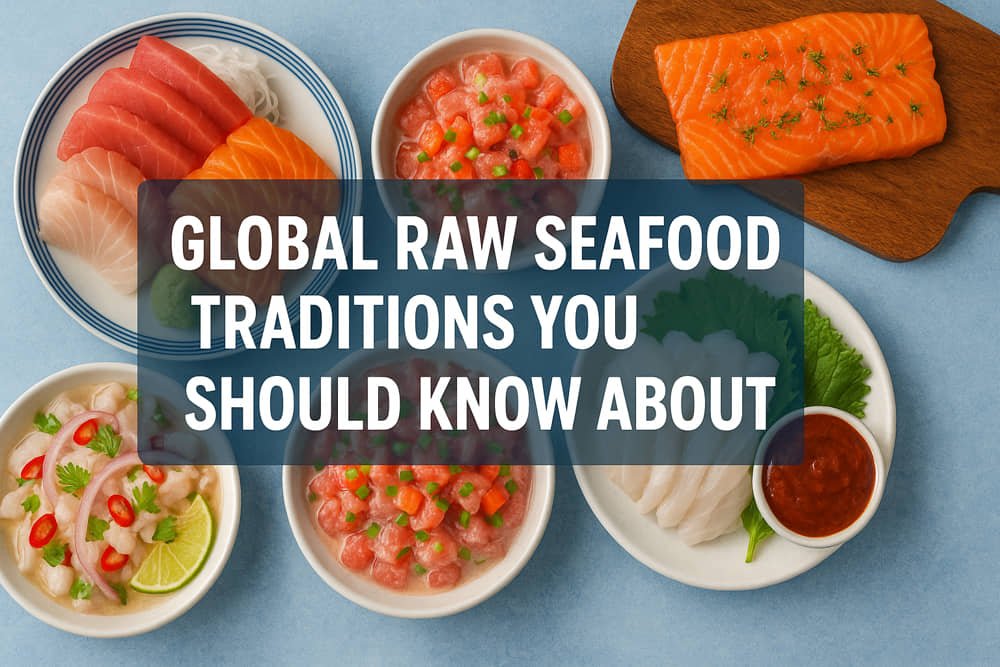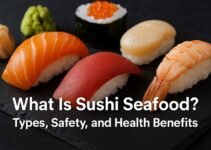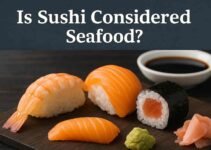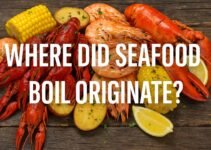Raw seafood is more than just a culinary trend—it’s a cultural expression rooted deeply in tradition, geography, and local ecosystems. From the refined slices of sashimi in Tokyo to the citrus-cured ceviche of coastal Peru, raw seafood has found its way into kitchens and dining tables around the world, shaped by centuries of adaptation and innovation.
Across continents, people have learned to work with the sea’s freshest bounty, developing techniques not only to enhance flavor but also to ensure safety. In many cultures, consuming raw fish or shellfish reflects not only a taste preference but also an intimate connection with the ocean and nature’s rhythms.
In this article, we’ll explore some of the most fascinating raw seafood traditions from around the globe, revealing how these dishes are prepared, what makes them unique, and how different cultures balance deliciousness with food safety.
Contents
- 1 Japan: The Art of Sushi and Sashimi
- 2 Korea: Hoe (회) – Raw Fish With Bold Flavors
- 3 Peru: Ceviche – Citrus-Cured Simplicity
- 4 Italy: Crudo – Simplicity From the Sea
- 5 Nordic Countries: Gravlax & Raw Seafood Preservation
- 6 Polynesia: Poisson Cru & Island Raw Fish Dishes
- 7 Africa & Middle East: Rare but Emerging Traditions
- 8 Food Safety in Global Raw Seafood Cultures
- 9 Beyond Borders: Where Curiosity Meets Culture
Japan: The Art of Sushi and Sashimi
No conversation about raw seafood would be complete without Japan. Sushi and sashimi are perhaps the most iconic representations of raw seafood globally. But beyond the familiar maki rolls lies a centuries-old practice rooted in discipline, freshness, and meticulous craftsmanship.
Sashimi, which typically consists of thinly sliced raw fish or seafood served without rice, is revered for its purity and delicate texture. Common fish choices include tuna (maguro), salmon (sake), yellowtail (hamachi), and flounder (hirame). Each is chosen not only for taste but also for its structural integrity and seasonal availability.
Sushi, while often using similar ingredients, adds vinegared rice and sometimes seaweed, balancing umami with tang. Both dishes demand precise knife work and attention to hygiene, and only sushi-grade fish—those that have been properly frozen and handled—should be consumed raw. This standard is essential to avoid parasites like anisakis, making the article What Does Sushi-Grade Mean? a valuable read for those curious about the safety standards behind raw fish consumption.
Beyond food, sushi and sashimi represent the Japanese philosophy of simplicity, respect for nature, and the importance of presentation. These principles have helped Japanese raw seafood become a benchmark for quality and elegance worldwide.
Korea: Hoe (회) – Raw Fish With Bold Flavors
Korean cuisine offers its own take on raw seafood with a dish known as hoe (회), often misunderstood as simply “Korean sashimi.” While similar in using fresh, raw slices of fish or shellfish, hoe brings a spicier, more communal experience to the table.
Unlike the minimalist approach in Japan, Korean hoe is typically served with gochujang (fermented red chili paste), sesame oil, garlic, or cho-gochujang (a tangy chili-vinegar sauce), along with perilla leaves, raw garlic, and thinly sliced vegetables. Diners often wrap a piece of fish in lettuce or perilla with condiments, creating bold flavor combinations in every bite.
Commonly used seafood includes halibut (gwang-eo), rockfish, octopus, and sea cucumber. Much of the raw fish is served freshly filleted at coastal markets or raw fish restaurants called hoejip, where you can choose your fish from a tank moments before it’s prepared.
Hoe reflects Korea’s dynamic food culture—flavorful, interactive, and socially engaging. It’s a must-try for anyone looking to experience raw seafood with a spicy, Korean twist.
Peru: Ceviche – Citrus-Cured Simplicity
In Peru, raw seafood finds a vibrant and zesty expression through ceviche—a dish where fresh fish is cured in citrus juice, typically lime or lemon, rather than cooked with heat. Recognized as Peru’s national dish, ceviche reflects the country’s coastal bounty and its rich culinary heritage that blends Indigenous, Spanish, and Asian influences.
Traditional Peruvian ceviche uses white fish such as sea bass or flounder, cut into cubes and marinated with lime juice, sliced red onions, cilantro, salt, and spicy ají limo peppers. The acid in the citrus “cooks” the fish by denaturing its proteins, giving it a firm texture and opaque color while retaining a fresh, oceanic flavor.
Each region of Peru may have its own variation—some adding corn, sweet potatoes, or seaweed. In Ecuador, for example, ceviche may include shrimp and tomato sauce, while in Mexico, it leans toward chopped styles with avocado and chili.
Ceviche not only showcases the freshness of local seafood but also demonstrates how traditional methods can safely prepare raw fish using natural acidity. This dish has become an international favorite, proving that simplicity and bold flavor can coexist beautifully in raw seafood traditions.
Italy: Crudo – Simplicity From the Sea
Italian seafood traditions often fly under the radar in discussions about raw fish, but crudo—literally meaning “raw”—has a long-standing presence in coastal regions such as Puglia, Sicily, and Liguria. Unlike the marinated ceviche or the delicately sliced sashimi, crudo emphasizes pristine ingredients, seasoned with restraint.
Crudo usually consists of thinly sliced or diced raw fish, drizzled with extra virgin olive oil, sprinkled with sea salt, and often topped with lemon zest or micro herbs. The dish can feature a variety of seafood including red snapper, tuna, langoustine, shrimp, or scallops.
The focus is on the essence of the sea. No overpowering sauces or garnishes distract from the fish’s natural taste. In southern Italy, especially in Bari, it’s not uncommon to see locals eating raw mussels or sea urchins freshly cracked open at the market.
Italian crudo echoes the Mediterranean philosophy of cooking: start with the best ingredients and do very little to them. It’s a celebration of purity, balance, and the sea’s quiet elegance on a plate.
Nordic Countries: Gravlax & Raw Seafood Preservation
In the cold northern reaches of Europe, raw seafood traditions took a different path—focusing on preservation rather than immediate consumption. Gravlax, a beloved Nordic specialty, is a cured salmon dish that dates back to medieval Scandinavia when fish was buried in sand to ferment slightly, hence the name “grave-lax” (buried salmon).
Modern gravlax is made by curing fresh salmon with a mixture of salt, sugar, and dill for several days. This process draws out moisture, firms up the flesh, and imparts a delicate, slightly sweet flavor that pairs beautifully with mustard sauce or rye bread.
Preservation-based methods allowed people in Norway, Sweden, Denmark, and Finland to enjoy raw or semi-raw fish year-round, even in frigid winters. Smoked and cured herring, pickled seafood, and roe are all part of the broader raw seafood spectrum in this region.
What distinguishes Nordic raw seafood is not just technique, but the emphasis on seasonality, sustainability, and minimalism. Gravlax, in particular, exemplifies how traditional knowledge meets modern culinary finesse—bridging history and flavor in every slice.
Polynesia: Poisson Cru & Island Raw Fish Dishes
Across the tropical islands of Polynesia, especially in Tahiti and French Polynesia, raw seafood takes on a refreshing and tropical twist through poisson cru—a dish that literally means “raw fish” in French. Known locally as ia ota, this delicacy reflects the island lifestyle: simple, fresh, and rooted in local ingredients.
Poisson cru is made with cubes of raw tuna or other reef fish marinated briefly in lime juice, then mixed with coconut milk, diced tomatoes, cucumbers, onions, and sometimes shredded carrots or bell peppers. The combination of citrus acidity and creamy coconut creates a balanced, mildly tangy flavor that contrasts beautifully with the freshness of the fish.
This dish is usually served chilled, often as a starter, and represents the islanders’ relationship with the sea and the land. Since refrigeration wasn’t widely available in the past, fish had to be caught and eaten immediately—fueling the cultural preference for raw preparations with fast, natural curing methods.
Variations of poisson cru can be found across the Pacific, from Samoa’s oka i’a to Hawaii’s poke, showing how indigenous knowledge and available resources shaped unique, nutrient-rich traditions that remain popular today.
Africa & Middle East: Rare but Emerging Traditions
Raw seafood is relatively rare in many parts of Africa and the Middle East, largely due to environmental factors, religious dietary laws, and culinary preferences that favor cooked or preserved foods. However, small pockets of raw seafood culture do exist—either through coastal influence or modern culinary adaptation.
In North African coastal cities like Alexandria (Egypt) or Tunis (Tunisia), there are instances of marinated seafood preparations using lemon and vinegar, somewhat reminiscent of ceviche. In Morocco and Algeria, sardines and anchovies may be briefly cured or lightly pickled to maintain freshness in hot climates.
In the Middle East, while raw fish is not traditionally common, there are parallel practices such as kibbeh nayyeh, a raw meat dish made from minced lamb or beef with bulgur and spices, which reflect similar culinary risk management through ingredient quality and seasoning. Some modern Lebanese and Israeli chefs are experimenting with raw sea bream and amberjack crudos, influenced by Mediterranean and Japanese styles.
As global palates expand and cold chain logistics improve, raw seafood is beginning to appear on gourmet menus in cities like Cape Town, Dubai, and Beirut—suggesting that raw seafood culture, while not historic in these regions, is part of an emerging fusion movement.
Food Safety in Global Raw Seafood Cultures
While the methods and ingredients may vary, one common thread unites all raw seafood traditions: a strong cultural emphasis on freshness and food safety. Across continents, people have developed intuitive and technical methods to enjoy raw fish without compromising health.
In Japan, the concept of “sushi-grade” fish refers to seafood that’s been flash-frozen to kill parasites—now a global standard. In Peru, the acidic citrus in ceviche reduces bacterial load. In the Nordic region, salt and sugar curing prevents spoilage. Even in the tropics, immediate consumption and the antimicrobial properties of lime and coconut help reduce foodborne risks.
Understanding these practices is vital, especially when preparing raw seafood at home. Readers looking to explore raw shellfish or similar dishes should refer to Is It Safe to Eat Raw Shellfish at Home? for best practices on sourcing, handling, and preparation.
Whether through natural preservatives, rapid processing, or modern refrigeration, these safety practices are what allow raw seafood to transcend risk and become a staple of global cuisine.
Beyond Borders: Where Curiosity Meets Culture
Raw seafood traditions remind us that cuisine is both deeply local and powerfully universal. From the refined rituals of Japan to the relaxed island fare of Polynesia, each raw seafood dish reflects not only regional flavors but also ancestral knowledge and environmental adaptation.
As the popularity of raw seafood grows, so too does the curiosity to explore and even recreate these dishes at home. For those ready to dive deeper, you might enjoy learning how to choose sashimi-grade seafood safely or discover can you eat scallops raw for your next coastal-inspired meal.
Exploring these global traditions is more than tasting new dishes—it’s a passport to understanding how humans have creatively and safely enjoyed the sea’s bounty for centuries.



